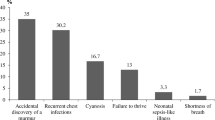Abstract
The aim of the study was to investigate the occurrence, pattern and clinical aspects of congenital heart diseases and their management in Cameroon. In this multicentred retrospective study from January 2006 till November 2009, out of 51,636 consulting in three referral centres, 505 were recruited. All the patients presented with the following symptoms: cyanosis, clubbing, frequent respiratory tract infections, failure to thrive, growth retardation, precordial murmur and dyspnoea. Patients were sent for the screening of congenital heart disease. After the comprehensive Doppler echocardiography, the recruited patients were diagnosed with congenital (67.2%) and in few, acquired heart disease. Heart murmur, dyspnoea and growth retardation was the triad mostly encountered. The occurrence of congenital heart diseases in Cameroon is 9.87%. In Douala, isolated ventricular septal defect, interatrial septal defect and isolated pulmonary valve stenosis were more diagnosed than in Shisong (P <0.05) and Yaoundé (P <0.05). In Yaoundé, there were more cases of common arterial trunk, transposition of great arteries with ventricular septal defect and Ebstein disease than in Shisong (P <0.05) and Douala (P < 0.05). At Shisong, tetralogy of Fallot, arterial duct, coarctation of the aorta, congenital mitral valve regurgitation, atresia of the tricuspid valve, double outlet right ventricle, anomalous pulmonary venous return and left isomerism were more diagnosed than in Yaoundé (P <0.05) and in Douala (P <0.05). Thirty percent of the patients were operated abroad; 9% in the cardiac centre. Conclusion: Our data show that congenital heart diseases are represented in Cameroon as in the literature; isolated ventricular septal defect is the predominant pathology.
Résumé
Le but de l’étude était d’analyser l’occurrence, le type, les aspects cliniques des cardiopathies congénitales ainsi que leur prise en charge au Cameroun. Cette étude multicentrique rétrospective s’est déroulée de janvier 2006 à novembre 2009. Sur 51 636 patients ayant consulté dans trois centres hospitaliers de référence camerounais, 505 ont été recrutés. Les patients devaient subir un dépistage de cardiopathies congénitales. Après une échocardiographie Doppler complète, 67,2 % des patients recrutés avaient une cardiopathie congénitale et les 32,8 % restant une maladie acquise du coeur. Le souffle précordial, la dyspnée d’effort et le retard de croissance constituaient la triade la plus fréquente. L’occurrence des cardiopathies congénitales au Cameroun est de 9,87‰. À Douala, la communication interventriculaire isolée, la communication interauriculaire, la sténose isolée de l’artère pulmonaire étaient plus diagnostiquées qu’à Shisong et à Yaoundé (p < 0,05). À Yaoundé, les cas de tronc artériel commun, transposition de gros vaisseaux avec communication interventriculaire et maladie d’Ebstein étaient plus fréquents qu’à Shisong (p < 0,05) et à Douala (p < 0,05). À Shisong, la tétralogie de Fallot, le canal artériel persistant, la coarctation de l’aorte, l’insuffisance mitrale congénitale, l’atrésie de la tricuspide, le ventricule droit à double issue, les retours veineux anormaux et l’isomérisme gauche étaient plus diagnostiqués qu’à Yaoundé (p < 0,05) et à Douala (p < 0,05). Trente pour cent de patients ont été opérés à l’étranger, 9 % au centre cardiaque de Shisong. Les cardiopathies congénitales sont représentées au Cameroun avec une occurrence de 9,87 ‰, fréquence correspondant aux chiffres indiqués dans la littérature. La communication interventriculaire isolée est la pathologie prédominante.
Similar content being viewed by others
Références
Bannerman CH, Mahalu W (1998) Congenital heart disease in Zimbabwean children. Ann Trop Paediatr 18(1):5–12
Bassili A, Mokhtar SA, Dabous NI, et al (2000) Congenital heart disease among school children in Alexandria, Egypt: an overview on prevalence and relative frequencies. J Trop Pediatr 46(6):357–362
Ejim EC, Ike SO, Anisiuba BC, et al (2009) Ventricular septal defects at the University of Nigeria Teaching Hospital, Enugu: a review of echocardiogram records. Trans R Soc Trop Med Hyg 103(2):159–161, Epub 2008 August 3
Sani MU, Mukhtar-Yola M, Karaye KM (2007) Spectrum of congenital heart disease in a tropical environment: an echocardiography study. J Natl Med Assoc 99(6):665–669
Tantchou Tchoumi JC, Butera G (2009) L’occurrence des valvulopathies postrhumatismales, type et suivi dans une zone rurale: l’expérience de l’hôpital de Shisong, Cameroun. Bull Soc Pathol Exot 102(3):155–158
Author information
Authors and Affiliations
Corresponding author
About this article
Cite this article
Tantchou Tchoumi, J.C., Ambassa, J.C., Chelo, D. et al. Pattern and clinical aspects of congenital heart diseases and their management in Cameroon. Bull. Soc. Pathol. Exot. 104, 25–28 (2011). https://doi.org/10.1007/s13149-010-0091-7
Received:
Accepted:
Published:
Issue Date:
DOI: https://doi.org/10.1007/s13149-010-0091-7




